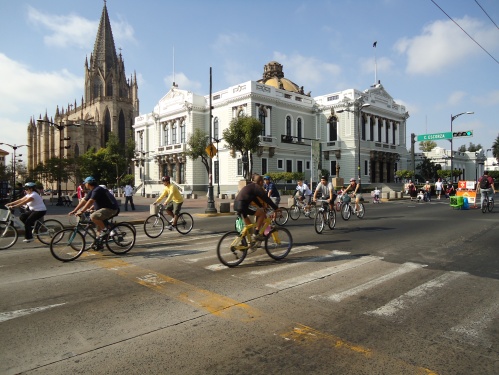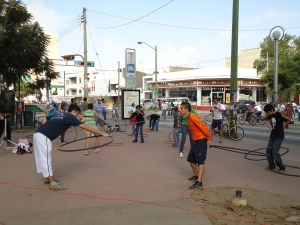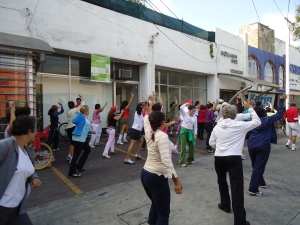To travel along this wide pedestrianized promenade, Paseo de la Reforma, is to voyage from the Aztec antiquities to Mexico’s capitalist modernity with monuments to all of Mexico’s varied roots from Greek Goddesses, Aztec Emperors, Spanish Colonial Kings & Conquistadors, Mexican Independence Heroes, Mexican Revolutionaries, and the Mexican Stock Exchange.Mexico City, one of the largest and oldest cities of the world, celebrates Mexico’s storied history and humanity by opening up its grandest boulevard to hundreds of thousands of people every Sunday. This 24km pedestrian, skating, and pedaling route snakes its way through the core of this great city and civilization.
This large boulevard is the favorite spot for celebration and angst in Mexican national civic life, a place for parades and protests. The weekly car free Sunday event, titled “Cambia de Carril y Muevete en Bici” or “Change Lanes and Move on Bike,” encourages residents, families, and visitors of Mexico City to enjoy this historic street on foot, skates, or bike.
The route turns from this grand boulevard into the crowded, busy, and narrow streets of the Historic District of Mexico City leading to the center of the Mexican Republic, government, & the site of the ancient Aztec city of Tenochtitlan, the Zocalo.
The route encircles the Zocalo and then heads to the spiritual capital of Mexico, the Basilica of Our Lady of Guadalupe, the national shrine devoted to the appearance of Mexico’s patron saint. The Basilica has been receiving pilgrims for almost 500 years continuously and is only second to the Vatican in number of annual pilgrims.
The municipal government sponsors and organizes this weekly event with great precision and coordination. The route was filled with people and most of all, families with children. The city provides many different services to encourage residents and visitors a chance to pedal through history with programs such as free bicycle mechanic stations, medical kiosks, free bicycle loans and children’s bicycle trailers loan stations along the weekly event. These compliment Mexico City’s already modern and large bike sharing network, EcoBici, which has many computerized kiosks along the route.
Many Non Governmental Organizations also arrange interesting programs at the “Change Lanes and Move on Bike”. Some of these include free public theater, environmental classes, yoga in the park, and photo & sculpture exhibitions. Two of the most creative programs are led by activists for the disabled. ‘Blind Bike’ is one of these programs, where the activists team up blind and disabled people on tandem bikes with more able bodied cyclists to allow the visually impaired a chance to enjoy the city from the saddle of a cycle, while having the sights described to them by their fellow pedaler! The other endearing project from these activists is “An Hour in Someone Else’s Shoes,” where people are encouraged to navigate the city in a wheelchair loaned to them, in the hopes of creating more empathy for the needs of the disabled community.
The most amazing aspect of the weekly event is how it takes place on what is, arguably, Mexico’s most important road. The street has a different monument at every intersection. Statues that are usually choked by cars & auto exhaust are liberated on these lazy Sunday mornings, easily approached by curious children and fumbling tourists. The route of Cambio de Carril y Muevete en Bici starts on the Paseo de la Reforma near the Presidential Residence. The first tribute is a fountain devoted to the Greek Goddess of Hunting and the Moon, Diana. When we attended the event, the fountain was being used as the start and finish line to a very well attended bicycle racing competition. Further to the North, was the bronze statue of the Angel of Independence, a monument and mausoleum to martyrs of the Mexican Independence of 1810. The city government had young university students loaning bikes at the base of the Angel, and we happily borrowed two of their bright yellow bikes, then joined in the giant bicycle procession that included people of all ages. Every other block, there were EcoBici stations, where members could rent bikes with a swipe of their card.
We pedaled along the route, excited to be on wheels again! Heading towards the Historic District, we entered into the center of finance in Mexico. The boulevard took us past the Mexican Stock Exchange, one of the tallest buildings in the Americas and we passed the embassies of the United States, Japan, Colombia, and the EU. In the midst of modernity, two separate monuments were staged a few blocks apart. One was to Cuauhtemoc, the Aztec emperor who was captured, tortured, and executed by Cortes and his invading Conquistadors. The other statue, at the next intersection, was to a Spaniard by the name of Cristobal Colon. Here in Mexico, where much of the nation is equally descended from each of these once opposing cultures, the Aztecs, and the Spanish, the juxtaposition had lost its irony. This road pulsed with people, art, history, and commerce. How excited we were to explore it at a relaxed pace from the vantage of a bicycle saddle.
What a treat that such a great nation makes the recreation of their citizens such a priority that they devote their most prized streets, monuments, and institutions to bicycles, skating, and walking every Sunday.
(Imagine Pennsylvania Avenue in Washington D.C. Being turned into a Pedestrian mall every Sunday!)
Story & photos by Ryan Hashagen & translated and edited by Lale Santelices.
We are currently travelling overland and sea from Portland, Oregon to Puerto Montt, Chile investigating Latin American cycling culture.
Follow our super wonky transportation travels on:
Facebook: Portland Pedicabs
Twitter: @portlandpedals & @GlobalGreenways
Flickr: http://www.flickr.com/Global Greenways
Our Cambia de Carril y Muevete en Bici or “Change Lanes and Move on Bike” Flickr Gallery:
http://www.flickr.com/photos/globalgreenways/sets/72157629609105333/






















